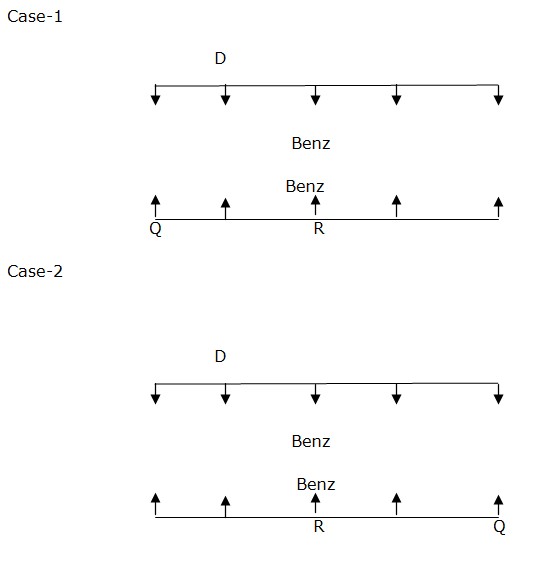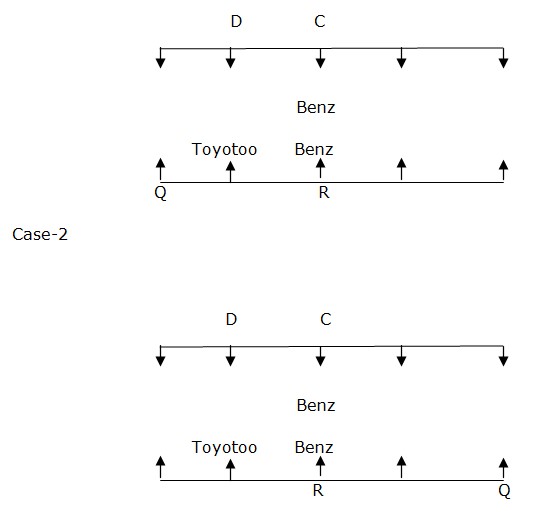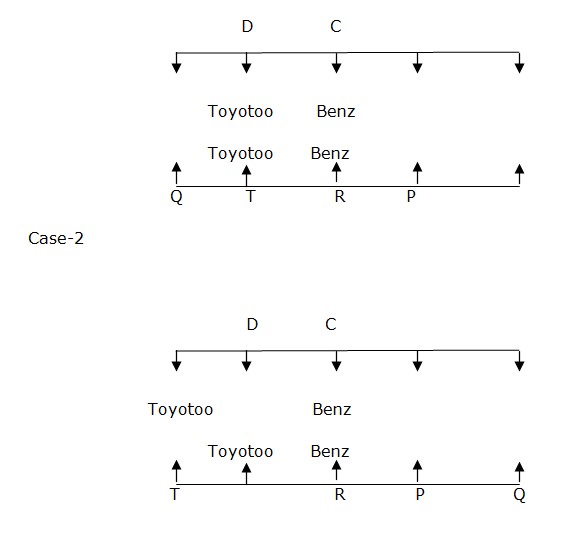Question
What is the position of T with respect to the one who
like Swift Car? Study the following information carefully and answer the given Questions below. Ten people are sitting in two parallel rows. A, B, C, D and E are sitting in row 1 facing South. P, Q, R, S and T are sitting in row 2 facing north. The person sitting in row 1 exactly faces the person sitting in row 2. They like five different cars, Benz, BMW, Audi, Toyotto and Swift. Exactly two people like the same Car and the persons who like the same Car don’t sit in the same row. Q sits at one of the extreme ends. There is only one person sits between Q and the one who faces the person who like Benz Car. D sits to the immediate right of the person who like Benz Car. There is one person sits between Q and R. R likes Benz Car. Number of persons who sits to the right of R is same as that of number of person who sits to the left of C. The person who likes Toyotto Car sits immediate left of R. Two people sit between T and P. T sits somewhere to left of P. T faces the one who like Toyotto Car. One of the people who like Swift Car is an immediate neighbor of the one who like Audi Car in row 2. E sits left of A. E is an immediate neighbor of B. B faces the person who sits to the immediate right of the person who like Swift Car. S and B doesn’t like Swift Car. There is only one person sits between D and the one who like BMW Car.Solution
Q sits at one of the extreme ends. There is only one person sits between Q and the one who faces the person who like Benz Car. D sits to the immediate right of the person who like Benz Car. There is one person sits between Q and R. R like Benz Car.  Number of persons who sits to the right of R is same as that of number of person who sits to the left of C. The person who likes Toyotto Car sits immediate left of R. Case-1
Number of persons who sits to the right of R is same as that of number of person who sits to the left of C. The person who likes Toyotto Car sits immediate left of R. Case-1  Two people sit between T and P. T sits somewhere to left of P. T faces the one who like Toyotto Car. Case-1
Two people sit between T and P. T sits somewhere to left of P. T faces the one who like Toyotto Car. Case-1  One of the people who like Swift Car is an immediate neighbour of the one who like Audi Car in row 2. E sits left of A. E is an immediate neighbour of B. B faces the person who sits to the immediate right of the person who like Swift Car. S and B doesn’t like Swift Car. There is only one person sits between D and the one who like BMW Car. Case 1 doesn’t satisfy above condition. So this case is eliminated. And Case 2 will be the final arrangement.
One of the people who like Swift Car is an immediate neighbour of the one who like Audi Car in row 2. E sits left of A. E is an immediate neighbour of B. B faces the person who sits to the immediate right of the person who like Swift Car. S and B doesn’t like Swift Car. There is only one person sits between D and the one who like BMW Car. Case 1 doesn’t satisfy above condition. So this case is eliminated. And Case 2 will be the final arrangement. 
Where is the headquarters of the small finance bank which launched Platina Fixed Deposit, which offers interest of 15 basis points in addition to the r...
Who released recommendations on "Encouraging Innovative Technologies, Services, Use Cases and Business Models through Regulatory Sandbox in Digital Comm...
PM Modi inaugurated Asia's biggest aero show “Aero India 2023”, what is its theme?
Persistent Systems has entered into a multi-year strategic collaboration agreement with which company to accelerate the pace of innovation and developme...
Which of the following is true about NHAI's plan to develop 10,000 km of 'Digital Highways' in India by 2025 ?
I . The project is aimed at provid...
What was the food inflation rate in urban areas for September 2025 as per the Consumer Price Index?
- Which Soviet chess Grandmaster, known for his famous Cold War match against Bobby Fischer, recently passed away at the age of 88?
According a report “Tech Start-ups: Quarterly Investment Factbook” recently, the total funding in the startup ecosystem dropped to what amou...
Consider the following statements about Middle-income trap:
I. Middle-income trap is a situation in middle-income countries where they are not ab...
What is the new LTV ratio for gold loans up to ₹2.5 lakh after RBI’s revision?
Relevant for Exams:


